Chem 104 experiment 2 - Study guides, Class notes & Summaries
Looking for the best study guides, study notes and summaries about Chem 104 experiment 2? On this page you'll find 27 study documents about Chem 104 experiment 2.
Page 2 out of 27 results
Sort by
QUESTIONS AND ANSWERS

-
First Semester Study Guide AP Chem Buck Exam 196 Questions with Verified Answers,100%CORRECT
- Exam (elaborations) • 47 pages • 2024
-
- $12.99
- + learn more
First Semester Study Guide AP Chem Buck Exam 196 Questions with Verified Answers Salts containing which of the following ions are generally insoluble in cold water? a. nitrate b. acetate c. phosphate d. potassium e. ammonium - CORRECT ANSWER C. Phosphate Which of the following changes alone would cause a decrease in the value of Keq for the reaction represented above? a. Decreasing the volume of the reaction vessel b. Adding a catalyst c. Increasing the volume of the reacti...
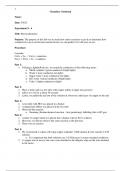
-
CHEM 104 Experiment 6: Electrochemistry - Portage Learning
- Exam (elaborations) • 3 pages • 2023
- Available in package deal
-
- $13.49
- + learn more
CHEM 104 Experiment 6: Electrochemistry - Portage Learning Purpose: The purpose of this lab was to study how redox reactions occur & to determine how conductivity can occur between metals & how we can predict if it will react or not. Procedure: Consider: Cu2+ + 2e- -> Cu(s) = reduction Fe(s) -> Fe2+ + 2e- = oxidation Part 1: 1. Utilizing a lightbulb device, we tested the conductive of the following items: a. Metal cylinder good conductor (bright light) b. Water poor conductor (no ...

-
CHEM 104 Experiment 5: Buffers - Portage Learning
- Exam (elaborations) • 4 pages • 2023
- Available in package deal
-
- $13.49
- + learn more
CHEM 104 Experiment 5: Buffers - Portage Learning Purpose: The purpose of this lab is to determine how buffers affect the pH of a solution in order to observe how a buffer is resistant to pH changes. Additionally, we determined how enzymes activity is affected by pH. Procedure: Part 1: Determine pH of sodium acetate in water & buffer 1. 2 pH electrodes are place in 2 separate beakers, one filled with tap water & one is filled with a pH 7 buffer (both have an approximate pH of 7) 2. A scoop of s...
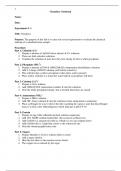
-
CHEM 104 Experiment 8: Urinalysis - Portage Learning
- Exam (elaborations) • 3 pages • 2023
- Available in package deal
-
- $13.49
- + learn more
CHEM 104 Experiment 8: Urinalysis - Portage Learning Purpose: The purpose of this lab is to carry out several experiments to evaluate the chemical makeup of a simulated urine sample. Procedure: Part 1: Chloride (Cl- ) 1. Prepare a mixture of AgNO3(silver nitrate) & Cl- solutions 2. These are both colorless solutions 3. Combine the solutions & note how they turn cloudy & form a white precipitate Part 2: Phosphate (PO3 -3) 1. Prepare a mixture of PO4 & (NH4)2MoO3 (Ammonium dimolybdate) solutions ...
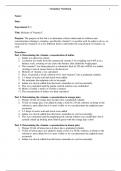
-
CHEM 104 Experiment 4: Molarity of Vitamin C - Portage Learning
- Exam (elaborations) • 3 pages • 2023
- Available in package deal
-
- $13.49
- + learn more
CHEM 104 Experiment 4: Molarity of Vitamin C - Portage Learning Purpose: The purpose of this lab is to determine a better understand of solutions and concentrations relating to vitamins, specifically vitamin C or ascorbic acid. In order to do so, we measured the vitamin C in a few different fruits to determine the concertation of vitamin c in each. Procedure: Part 1: Determining the vitamin c concentration of iodine 1. Iodine was placed in a buret. 2. A solution was made from the commercial vit...
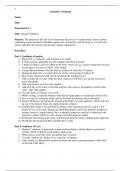
-
CHEM 104 Experiment 7 Organic Synthesis - Portage Learning
- Exam (elaborations) • 4 pages • 2023
- Available in package deal
-
- $14.49
- + learn more
CHEM 104 Experiment 7 Organic Synthesis - Portage Learning Purpose: The purpose of this lab was to determine the process of synthesizing various carboncontaining organic products including aspirin, urea, & salicylic acid. In doing so, we were also able to calculate the percent yield in each of these experiments. Procedure: Part 1: Synthesis of aspirin 1. Placed 2.0 g of salicylic acid & placed it in a flask 2. 5.0 mL of acetic anhydride was then added to the flask & mixed 3. 5 drops of sulfuric...
QUESTIONS AND ANSWERS
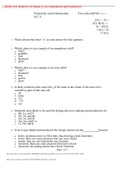
-
CHEM 102 Winter 12 Exam 2 (A) Questions and Answers,100% CORRECT
- Exam (elaborations) • 9 pages • 2023
-
- $14.99
- + learn more
CHEM 102 Winter 12 Exam 2 (A) Questions and Answers Potentially useful information: First order half-life: t1/2 = ln2 / k [A]t = - kt + [A]o ln[A]t = - kt + ln[A]o 1/[A]t = kt +1/[A]o 1. Please choose the letter “a” as your answer for this question. 2. Which choice is an example of an amorphous solid? a. NaCl b. graphite c. iron d. diamond e. glass 3. Which choice is an example of an ionic solid? a. NaCl b. diamond c. iron d. quartz e. glass 4. In body-centered cubi...
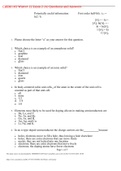
-
CHEM 102 Winter 12 Exam 2 (A) Questions and Answers,100% CORRECT
- Exam (elaborations) • 9 pages • 2023
-
- $14.99
- + learn more
CHEM 102 Winter 12 Exam 2 (A) Questions and Answers Potentially useful information: First order half-life: t1/2 = ln2 / k [A]t = - kt + [A]o ln[A]t = - kt + ln[A]o 1/[A]t = kt +1/[A]o 1. Please choose the letter “a” as your answer for this question. 2. Which choice is an example of an amorphous solid? a. NaCl b. graphite c. iron d. diamond e. glass 3. Which choice is an example of an ionic solid? a. NaCl b. diamond c. iron d. quartz e. glass 4. In body-centered cubi...

That summary you just bought made someone very happy. Also get paid weekly? Sell your study resources on Stuvia! Discover all about earning on Stuvia




